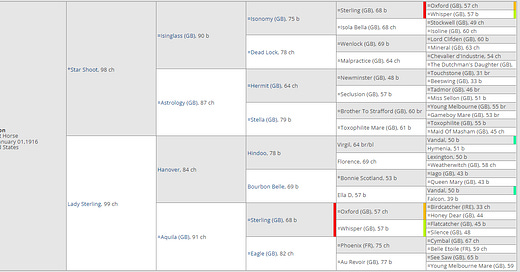Historic Pedigrees: Sir Barton
The first Triple Crown winner is a classic example of female family linebreeding
Before the term “Triple Crown” was used to describe Gallant Fox’s sweep of the Kentucky Derby, Preakness Stakes, and Belmont Stakes in 1930, the series was swept by a chestnut colt by Star Shoot named Sir Barton.
Sir Barton’s first career victory came in that Kentucky Derby, his sophomore debut after going 0-for-6 as a two-year-old. He won wire-to-wire and three days later did the same in the Preakness Stakes. Ten days later, he won the May 24th Withers Stakes before setting a then-record for 1 3/8 miles in the Belmont Stakes on June 11th. He won eight of his thirteen starts that year, then returned at four to win five times, including a world record-setting performance going 1 3/16 miles in 1:55 3/5 in the Merchants and Citizens Handicap.
Sir Barton was highly regarded from birth, as a son of multiple leading sire Star Shoot and the stakes-placed Hanover mare Lady Sterling, who was already the dam of 1908 champion juvenile male Sir Martin. He was inbred 4x3 to the excellent stallion Sterling, the sire of four classic winners including two-time Ascot Gold Cup winner Isonomy, Star Shoot’s grandsire.
Lady Sterling’s sire, Hanover, was a winner of the first 17 races of his career, including the Belmont Stakes, and was North America’s leading sire from 1895 through 1898. He was one of the first horses inducted into the National Museum of Racing and Hall of Fame. Hanover was inbred 3x3 to Vandal, a member of Lowe family 12b tracing to the 1754 Cullen Arabian mare Diana. Hanover’s sire, Hindoo, was out of a mare by the great Lexington, whose third dam Lady Grey was the fourth dam of Vandal. Hanover got another dose of this female family via his fourth damsire, Wild Medley. Interestingly, Lady Sterling’s damsire Sterling, as a member of family 12a, traced tail-female to a mare named Principessa, who was out of a full sister to Diana.
Both Star Shoot and Lady Sterling traced tail-female to the taproot mare Maid of Masham, a daughter of Don John who was inbred 3x3 to the stallion Comus (whose second dam Alexina is the 5th dam of Sir Barton’s third damsire, Phoenix). Star Shoot was out of the Hermit mare Astrology, whose modern tail-female descendants include horses such as West Coast, Le Vent Se Leve, and Hampton Court. Other descendants of Star Shoot’s third dam, Maid of Masham’s 1861 Toxophilite Mare responsible for Lowe family 9f, include Bull Lea, Bold Forbes, Slew O’ Gold, Distorted Humor, and Lookin at Lucky, among many others. Lady Sterling’s 4th dam was the 1859 Young Melbourne Mare, another daughter of Maid of Masham who is the taproot mare of Lowe family 9g, responsible for the likes of Kitasan Black, Cee’s Tizzy, Catholic Boy, and Fort Larned. Thus, Sir Barton was inbred 5x6 to his sixth dam, and both his sire and dam shared the “G2” mitochondrial haplotype.
I briefly touched on the success of linebreeding to family 9f in this post, but there are multiple examples of this pattern throughout history. Mark-ye-well, a fourteen-time winner for Calumet Farm whose stakes victories include the American Derby, Santa Anita Handicap, and San Antonio Handicap, was a grandson of family 9f’s Nellie Flag by family 9f’s Bull Lea. He was inbred 3x5 to his fifth dam, Colonial, who is also the tail-female ancestor of Distorted Humor and Lookin at Lucky. Kentucky Derby winner Country House is a member of family 9f by Lookin at Lucky, while G1 winner Varda is a member of family 9f by Distorted Humor. G1 Wood Memorial winner Thirty Six Red was inbred 4x5 to his fifth dam, Bourtai, who was the third dam of his sire, Slew O’ Gold. Bourtai’s fourth dam, The Apple, like Star Shoot’s dam Astrology, was a granddaughter of the 1861 Toxophilite Mare by Hermit.
As a stallion, Sir Barton was generally regarded as a disappointment, although he did get 1928 Kentucky Oaks winner and champion three-year-old filly Easter Stockings. His bloodline has been largely diminished in the modern era, primarily carried by descendants of Copelan, whose fifth dam was by Sir Barton but who himself is a fairly rare influence in modern pedigrees. He’s the damsire of Rockport Harbor and Lantana Mob, the second damsire of Cajun Breeze, and the third damsire of Wicked Strong.
Although Sir Barton’s influence as a stallion is essentially non-existent in the modern Thoroughbred, it’s fascinating to take a look at some of the pedigree components that may have led to him being one of the most important horses of the 20th century. To read more about Sir Barton and his legacy, I highly recommend Jennifer Kelly’s “Sir Barton and the Making of the Triple Crown,” which you can buy here.




